AUDI A5 COUPE 2012 Owners Manual
Manufacturer: AUDI, Model Year: 2012, Model line: A5 COUPE, Model: AUDI A5 COUPE 2012Pages: 316, PDF Size: 78.59 MB
Page 261 of 316
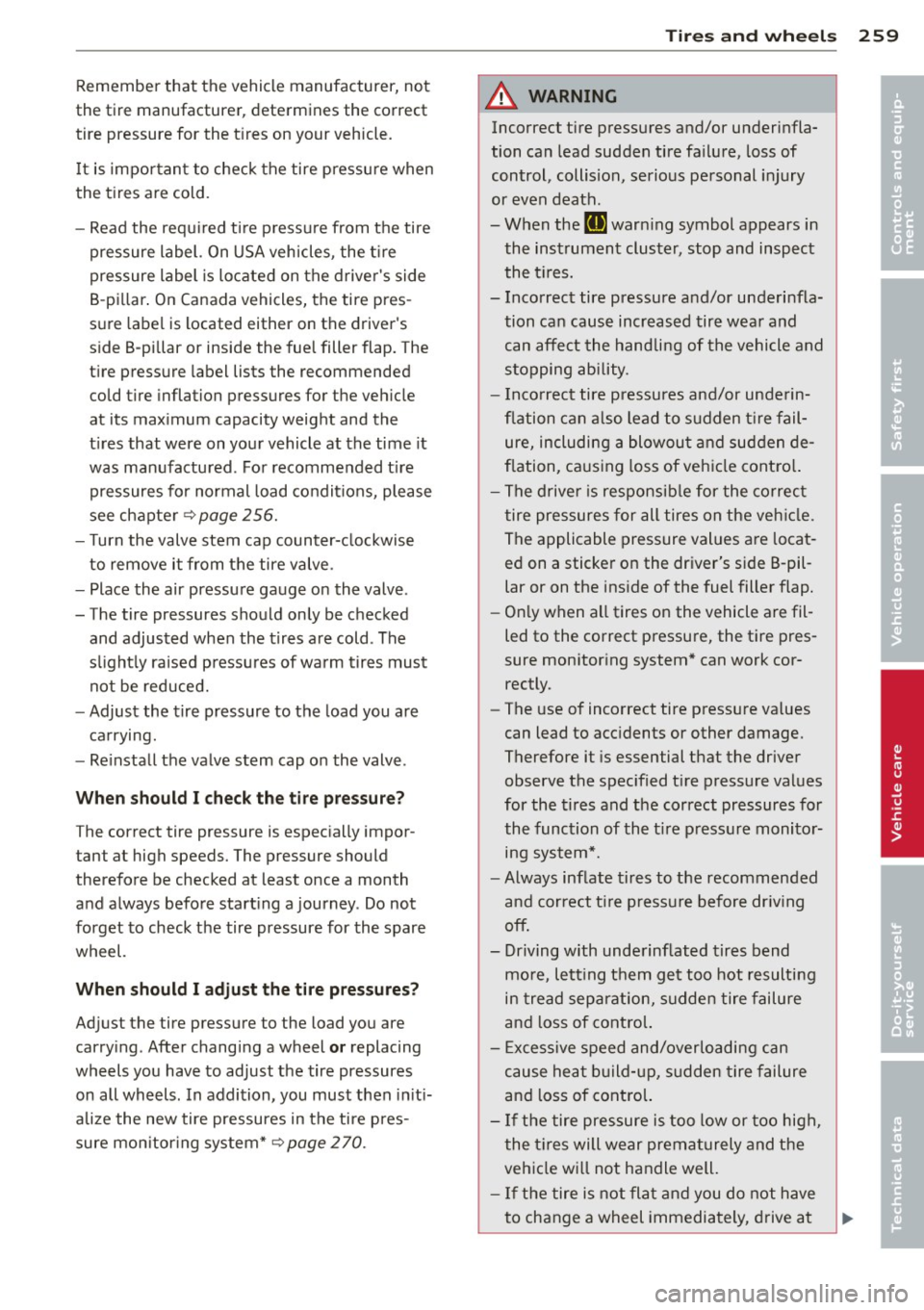
Remember that the vehicle manufacturer, not
the tire manufacturer, determines the correct
tire pressure for the t ires on your vehicle .
It is importan t to check the tire pressu re when
the t ires a re cold .
- Read the requ ired ti re p ressure from the tire
pressure label. On USA veh icles, the t ire
pressure label is located on the drive r's side
B-pi llar . On Canada vehicles, the tire pres
s u re label is located either on the driver's
s ide B-pi llar or inside the fue l filler flap . The
t ire press ure label lists the recommended
cold tire inflation pressures for the veh icle
at its max imum capacity weight and the
t ires that were on your vehicle at the time it
was manufactured . Fo r recommended t ire
pressures fo r normal load condit ions, please
see chapter
9page 256.
- T urn the valve stem cap counter-clockwise
to remove it from the tire valve .
- Place the air pressu re ga uge on the valve .
- The tire pressures should only be checked
and adjusted when the tires a re cold . The
s li ghtly raised p ressures of warm tires must
not be reduced.
- Adjust the tire pressure to the load you a re
c a rrying.
- Re install the valve stem cap o n the valve .
When should I check the ti re pres sure ?
The correct tire pressure is espec ially impor
tant at high speeds. The pressure should
therefore be checked at least once a month
and a lways befo re start ing a journey . Do not
forget to check the tire pressure for the spare
wheel.
When should I ad ju st the tire p re ss ures?
Adjust the tire pressure to the load you are
carry ing . After chang ing a wheel
or replacing
wheels you have to adjust the tire pressures
on all wheels. In addition , you must then in it i
alize the new tire pressures in the tire pres
sure mon itor ing system*
9 page 270.
Tire s an d wheel s 259
_& WARNING
Incorrect tire pressures and/or underinfla
tion can lead sudden tire fa ilure, loss of
control, collision, serio us pe rsonal injury
or even death.
- When the
ti] warn ing symbol appears in
the instrument cluster, stop and inspect
the t ires.
- Inco rrect tire pressure and/or underinfla
tion can cause increased tire wea r and
can affect the handling of the vehicle and
s topping ability.
- I nco rrect tire pressures and/or unde rin
f lation can a lso lead to sudden t ire fail
ure, including a blowou t and sudd en de
f lation, ca using loss of veh icle cont ro l.
- T he drive r is responsi ble for the co rrec t
tire pressures for all tires on the veh icle.
The appli cable pressure values a re locat
ed on a sticke r on the dr iver's side B -pil
lar or on the inside of the fuel filler flap.
- On ly when all tires on the vehicle are fil
led to the correct pressure, the t ire pres
sure mon itor ing system * can work cor
rectly.
- The use of incorrect tire pressu re va lues
can lead to acc idents or other damage.
Therefore it is essential that the driver
observe the spec ified t ire pressure values
for the tires and the correct pressures for
the function of th e ti r e p ress ure monito r
ing system*.
- Always inf late tires to the recommended
a nd correct t ire p ress ure before dr iv ing
off.
- Driving with unde rinflated tir es bend
mo re, lett ing t hem get too hot resulting
in tre ad separation, sudden tir e fa ilure
and loss of cont rol.
- Exces sive speed and/overloading can
cause heat b uild- up, s udden tire failure
an d l oss of cont rol.
- If the tire pressure is too low or too high,
the t ires will wear prema turely and the
vehicle wi ll not handle well.
- I f the tire is not fla t and you do not have
to change a wheel immedia tely, drive a t •
•
Page 262 of 316
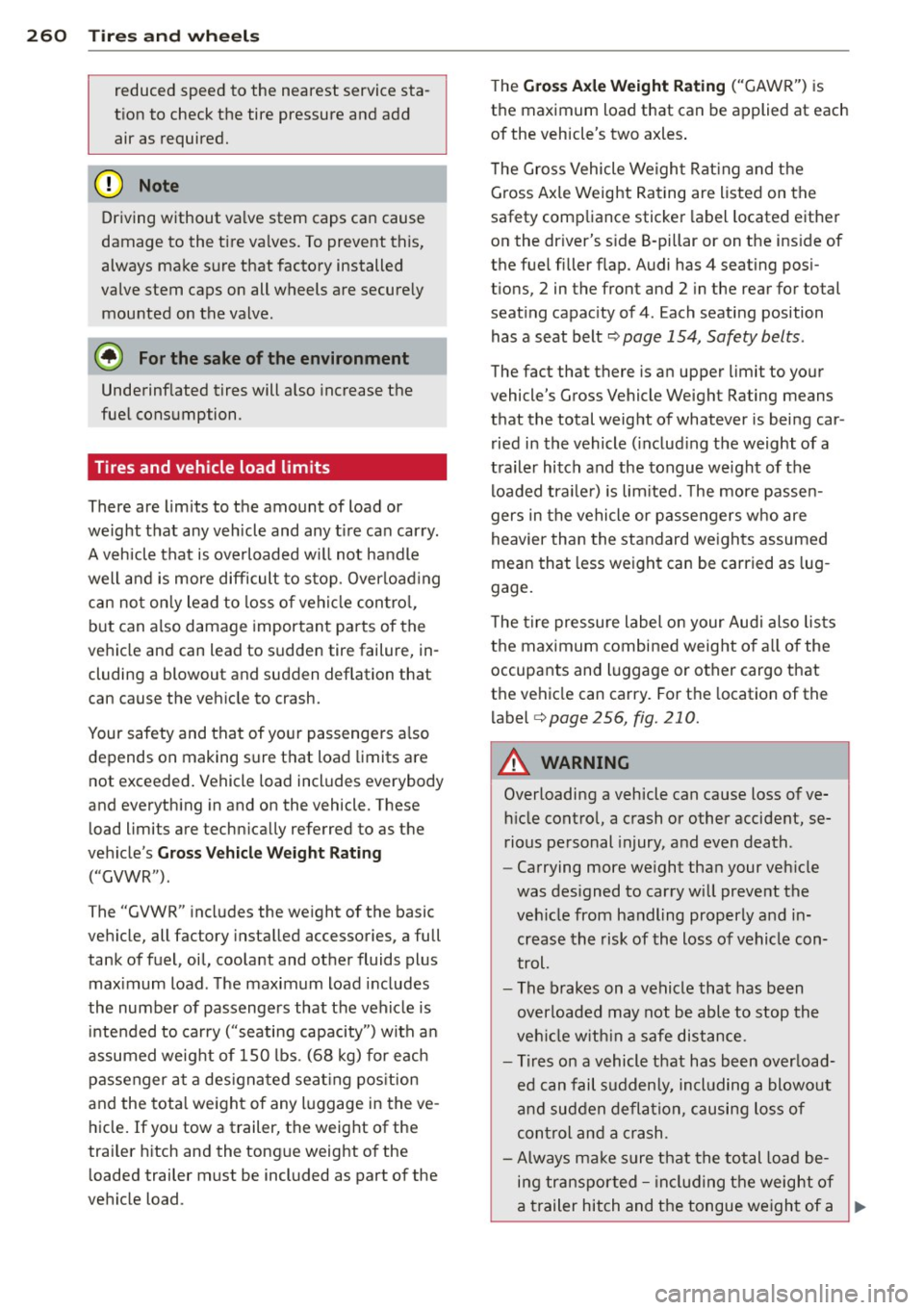
260 Tire s and wheel s
reduced speed to the nearest service sta
t ion to c heck t he tire pressure a nd add
air as required.
Driving without va lve stem caps can cause
damage to the tire va lves. To prevent this,
always make sure that factory installed
valve stem caps on all wheels are secure ly
mounted on the valve .
@I For the sake of the environment
Underinflated tires will also increase the
fue l consumption .
Tires and vehicle load limits
There are limits to the amount of load or
weight that any vehicle and any t ire can carry.
A vehicle that is ove rloaded w ill not ha ndle
well and is more difficult to stop. Over load ing
can no t on ly lead to loss of vehi cle contro l,
but can also damage important pa rts of the
ve hicle and can lead to sudden tire failure, in
cluding a blowout and sudd en deflation that
can cause the veh icle to crash.
Your safety and that of yo ur passenge rs a lso
depends on making s ure that load limits are
not exceeded . Vehicle load includes everybody
and everyth ing in and on the vehicle . These
load limits are techn ically referred to as the
ve hicle's
Gross Veh icle W eight Rat ing
(" GVWR ").
T he "GVWR" incl udes the we ight of the basic
vehicle, all f actory installed accessories, a full
tank of fuel, oil, coolant and other fluids plus maximum load . T he maximum load includes
the number of passengers that the vehicle is in tended to carry ("seating capacity") with a n
assumed weig ht of 150 lbs . (68 kg) for e ach
passenger at a des igna ted seat ing pos ition
and the tota l we ight of any l uggage in the ve
h icle. If you tow a trailer, the weight of the
tra iler hitch and the tong ue weight of the
loaded trailer must be included as part of the
ve hicle load . T
he
Gro ss Axle We ight Rating ("GAWR") is
the maximum load that can be applied at each
of the veh icle's two axles .
T he Gross Vehicle Weigh t Rat ing and the
G ross Ax le Weight Rating are listed on the
safety comp liance sticker label located either
on the dr iver's s ide B-pillar or on the ins ide of
the fuel fi ller flap . Audi has
4 seating pos i
t ions, 2 in the front and 2 in the rear for to tal
seat ing capac ity of 4 . Each seating position
has a seat belt ¢
page 154, Safety belts.
The fact that there is an upper limit to yo ur
vehicle 's Gross Vehicle Weight Rating means
that the total weight of whatever is being car ried in the vehicle ( includ ing t he weight of a
t railer hitch and the tongue weight of the
l oaded tra ile r) is lim ited. The more passen
gers in the vehicle or passengers w ho are
heavier tha n t he standard we ights assumed
mean that less weight can be carried as lug
gage.
T he tire pressure label o n your Aud i also lis ts
the max imum combi ned weight of a ll of the
occupants and luggage or other cargo that
t h e vehicle can carry. Fo r the location of the
label ¢
page 256 , fig. 210.
A WARNING
-Overloading a vehicle can cause loss of ve-
h icle contro l, a crash or other accident, se
rious pe rsonal injury, and even death .
- Carrying more we ight than your veh icle
was des igned to carry will prevent the
veh icle from handling properly and in
crease the risk of the loss of vehicle con
trol.
- The b rakes on a vehicle that has been
overloaded may not be abl e to stop the
veh icle w it hi n a safe distance .
- Tires on a vehicle that has been overload
ed can fail s udden ly, incl uding a blowo ut
a nd sud den defla tion, causing loss of
con trol an d a crash.
- Always make sure that the total load be
i n g tr anspor ted - incl ud ing t he weight o f
a trailer hitch and the tongue we igh t of a
~
Page 263 of 316
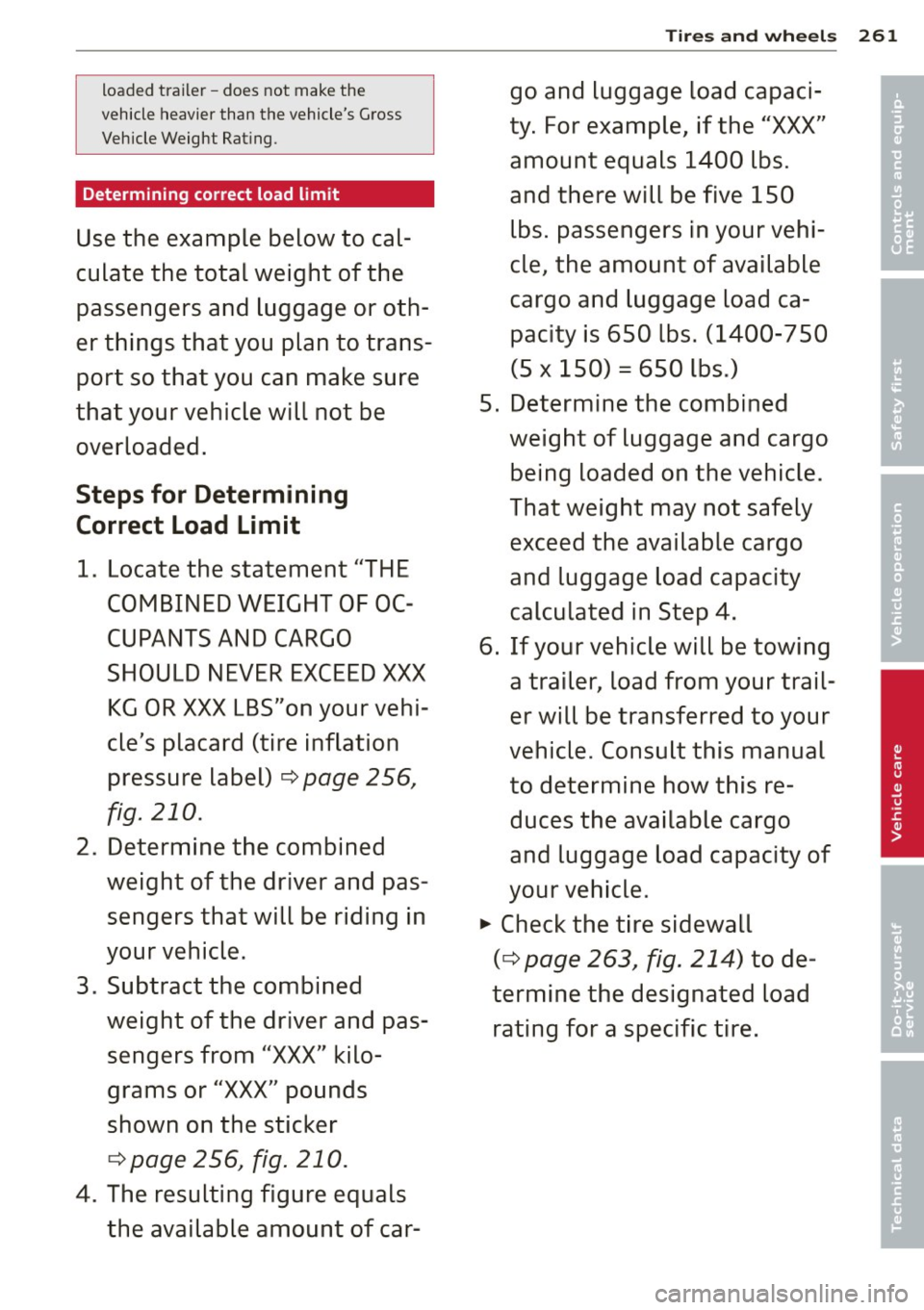
loaded traile r - does not make the
vehicle heavi er than the vehicle's G ross
Vehicle Weight Rat ing.
Determining correct load limit
Use the example below to cal
culate the total weight of the
passengers and luggage or oth
er things that you plan to trans
port so that you can make sure
that your vehicle will not be
overloaded.
Steps for Determining
Correct Load Limit
1. Locate the statement "THE
COMBINED WEIGHT OF OC
CUPANTS AND CARGO
SHOULD NEVER EXCEED XXX KG OR XXX LBS"on your vehi
cle's placard (tire inflation
pressure label)
¢ page 256 ,
fig. 210 .
2. Determine the combined
weight of the drive r and pa s
sengers that will be riding in
your vehicle.
3 . Subtract the combined
weight of the driver and pas
sengers from
" XXX " kilo
grams or
"XXX " pounds
shown on the sticker
¢page 256 , fig. 210.
4. The resulting figure equals
the available amount of car-
Tires and wheels 261
go and luggage load capaci
ty. For exampl e, if the
"XXX"
amount equal s 1400 lbs.
and there will be five 150
lb s. passengers in your vehi
c le, the amount of available
c argo and lugga ge load ca
pacity is 650 lb s. (1400-7 50
(5
X 150) = 650 lbs .)
5. Dete rmine the combined
weight of luggage and cargo being loaded on the vehi cle .
That weight may not safely exceed the available cargo
and luggage load capa city
cal culated in Step
4.
6 . If your vehi cle will be towing
a trailer , load from your trail
er will be transferred to your
vehicle. Consult this manual
to determine how this re duce s the available cargo
and luggage load capacity of
your vehicle .
~ Check the tire sidewall
(¢ page 263 , fig. 214) to de
term ine the designated load
rating for a specif ic t ire.
•
•
'
Page 264 of 316
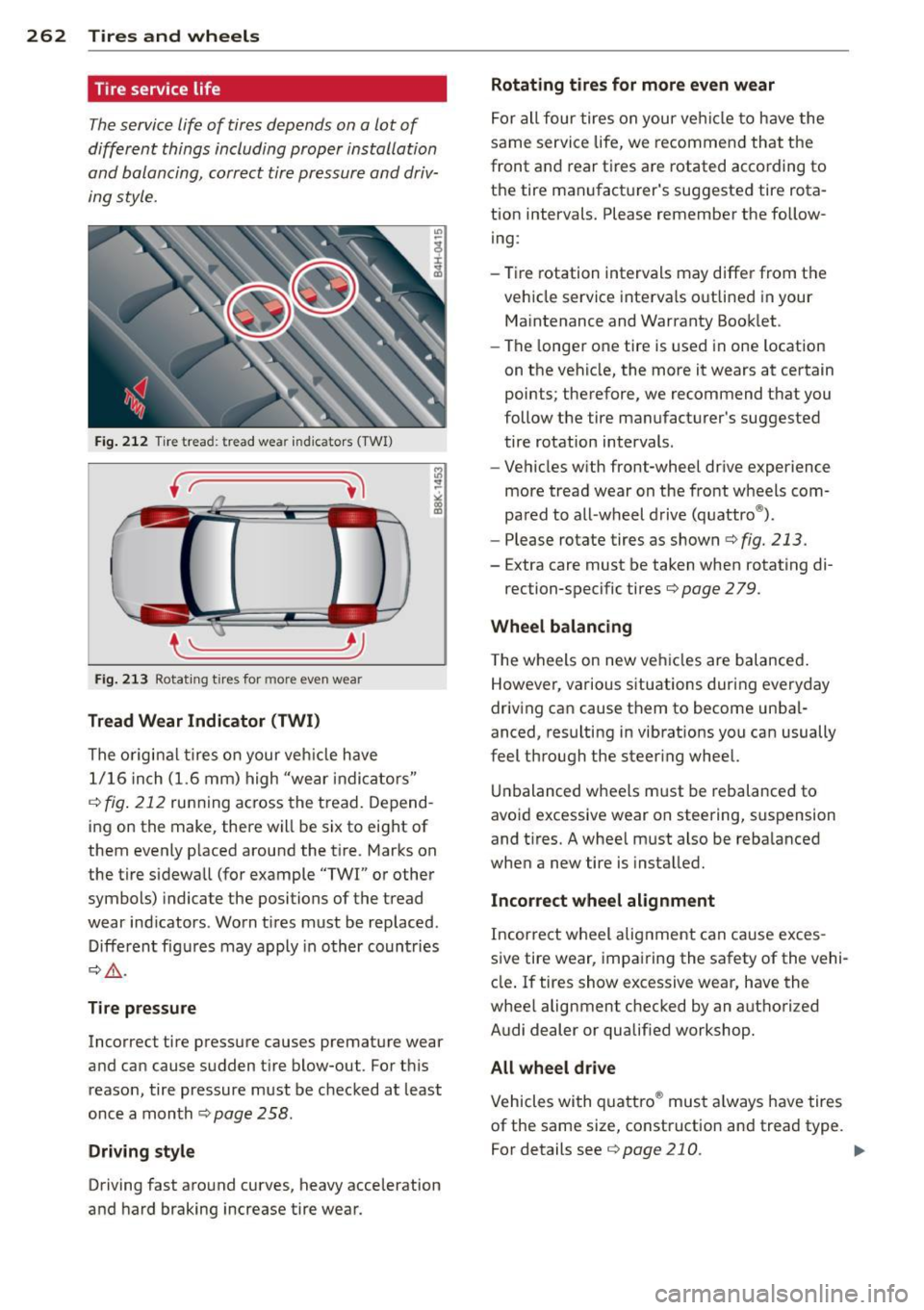
262 Tires and wheels
Tire service life
The service life of tires depends on a lot of
different things including proper installation
and balancing, correct tire pressure and driv
ing style.
Fig. 212 Tire tread: tread wear ind icators (TWI)
_____ __,.J)
Fig. 213 Rotating t ires for more even wear
Tread Wear Indicator (TWI)
The origina l tires on your veh icle have
1/16 inch (1.6 mm) high "wear indicators"
¢
fig . 212 running across the tread. Depend
ing on the make, there will be six to eight of
them evenly placed around the tire. Marks on
the tire sidewa ll (for example "TWI" or other
symbols) indicate the positions of the tread
wear ind icators . Worn tires must be replaced .
Different figures may apply in other countries
¢ & .
Tire pressure
Incorrect tire pressure causes premature wear
and can cause sudden t ire blow-out. For th is
reason, tire pressure must be checked at least
once a month
¢ page 258.
Driving style
Driving fast around curves, heavy acceleration
and hard braking increase tire wear.
Rotating tires for more even wear
For all four tires on your vehicle to have the
same service life, we recommend that the
front and rear tires are rotated according to
the tire manufacturer's suggested tire rota
tion intervals. Please remember the follow
ing:
- Tire rotation intervals may differ from the
vehicle service interva ls outlined in your
Ma intenance and Warranty Booklet .
- The longer one tire is used in one location
on the vehicle, the more it wears at certain
points; therefore, we recommend that you
follow the tire manufacturer's suggested
tire rotation intervals .
- Vehicles with front-wheel drive experience
more tread wear on the front wheels com
pa red to all-wheel drive (quattro ®).
- Please rotate tires as shown¢
fig. 213.
-Extra care must be taken when rotating di-
rection-specific tires¢
page 279.
Wheel balancing
The wheels on new vehicles are balanced.
However, various situations during everyday
driving can cause them to become unbal
anced, resulting in vibrations you can usually
feel through the steer ing wheel.
Unbalanced wheels must be rebalanced to
avoid excessive wear on steering, suspension
and tires. A wheel must also be rebalanced
when a new tire is installed.
Incorrect wheel alignment
Incorrect wheel alignment can cause exces
sive tire wear, impairing the safety of the vehi
cle. If tires show excessive wear, have the
whee l alignment checked by an authorized
Audi dealer or qualif ied workshop.
All wheel drive
Vehicles with quattro ® must a lways have tires
of the same size, construction and tread type.
For details see
¢page 210. ..,.
Page 265 of 316
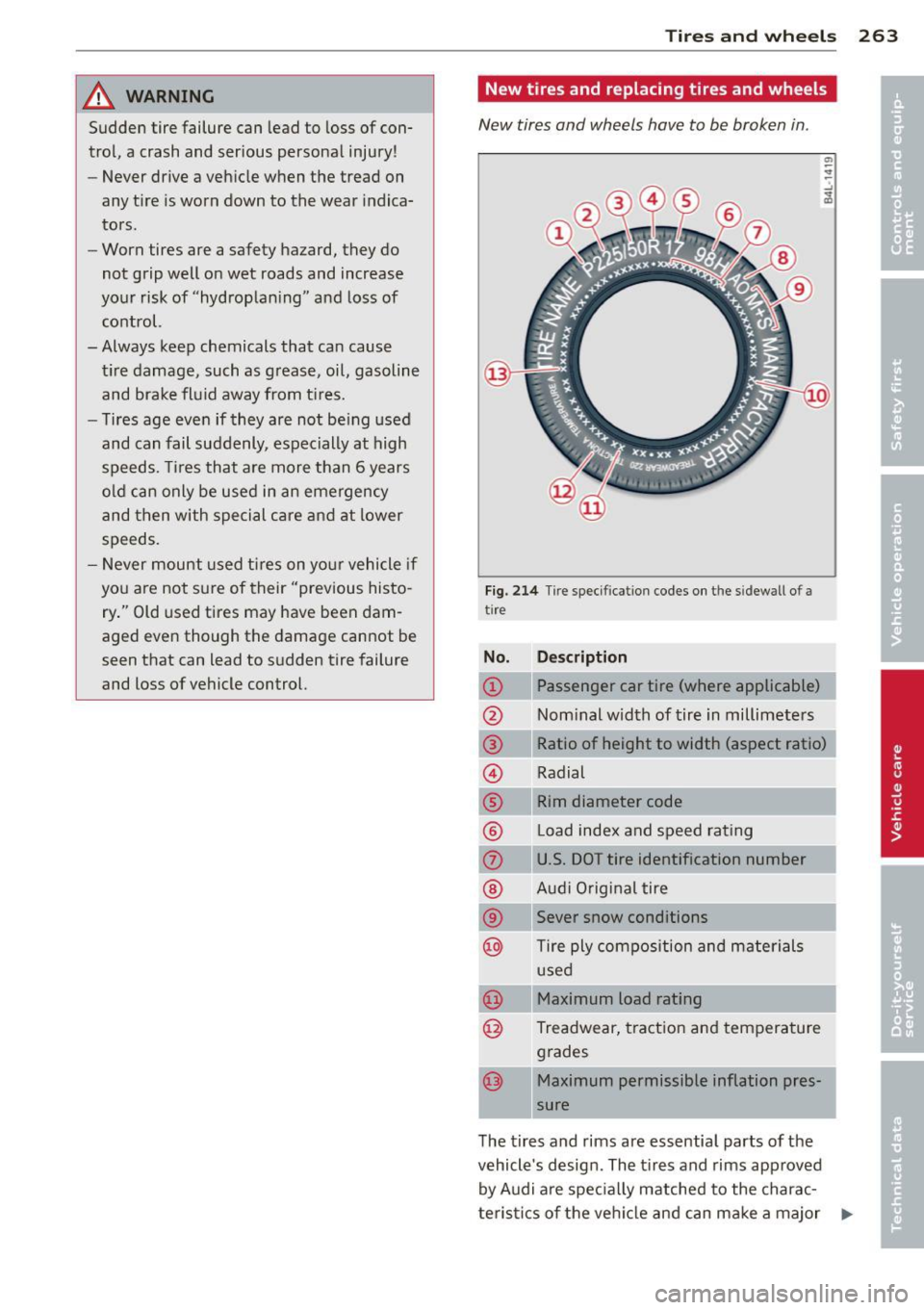
A WARNING
Sudden tire failure can lead to loss of con
trol, a crash and serious personal injury!
- Never drive a vehicle when the tread on
any tire is worn down to the wear indica
tors.
- Worn tires are a safety hazard, they do
not grip well on wet roads and increase
your risk of "hydroplaning" and loss of
control.
- Always keep chemicals that can cause
tire damage, such as grease, oil, gasoline
and brake fluid away from t ires.
- Tires age even if they are not be ing used
and can fail suddenly, especially at high
speeds . Tir es that are more than 6 years
old can only be used in an emergency
and then with special care and at lower
speeds.
- Never mount used tires on your vehicle if
you are not sure of their" previous histo
ry ." Old used tires may have been dam
aged even though the damage cannot be
seen that can lead to sudden tire failure
and loss of vehicle control.
Tires and wheels 263
New tires and replacing tires and wheels
New tires and wheels have to be broken in .
Fig. 214 Tir e specificat ion codes on t he s idewall o f a
tire
No. Description
CD Passenger car tire (where applicable)
@ Nominal width of tire in millimeters
® Ratio of height to width (aspect ratio)
© Radial
® Rim diameter code
® Load index and speed rat ing
(f) U.S. DOT tire identification number
® Audi Original tire
® Sever snow conditions
@ Tire ply composition and materials
used
@ Maximum load rating
@ Treadwear, traction and temperature
grades
@ Maximum permissible inflation pres-
sure
The tires and rims are essential parts of the
vehicle's design . The tires and rims approved
by Audi are specially matched to the charac
teristics of the vehicle and can make a major .,.
•
Page 266 of 316
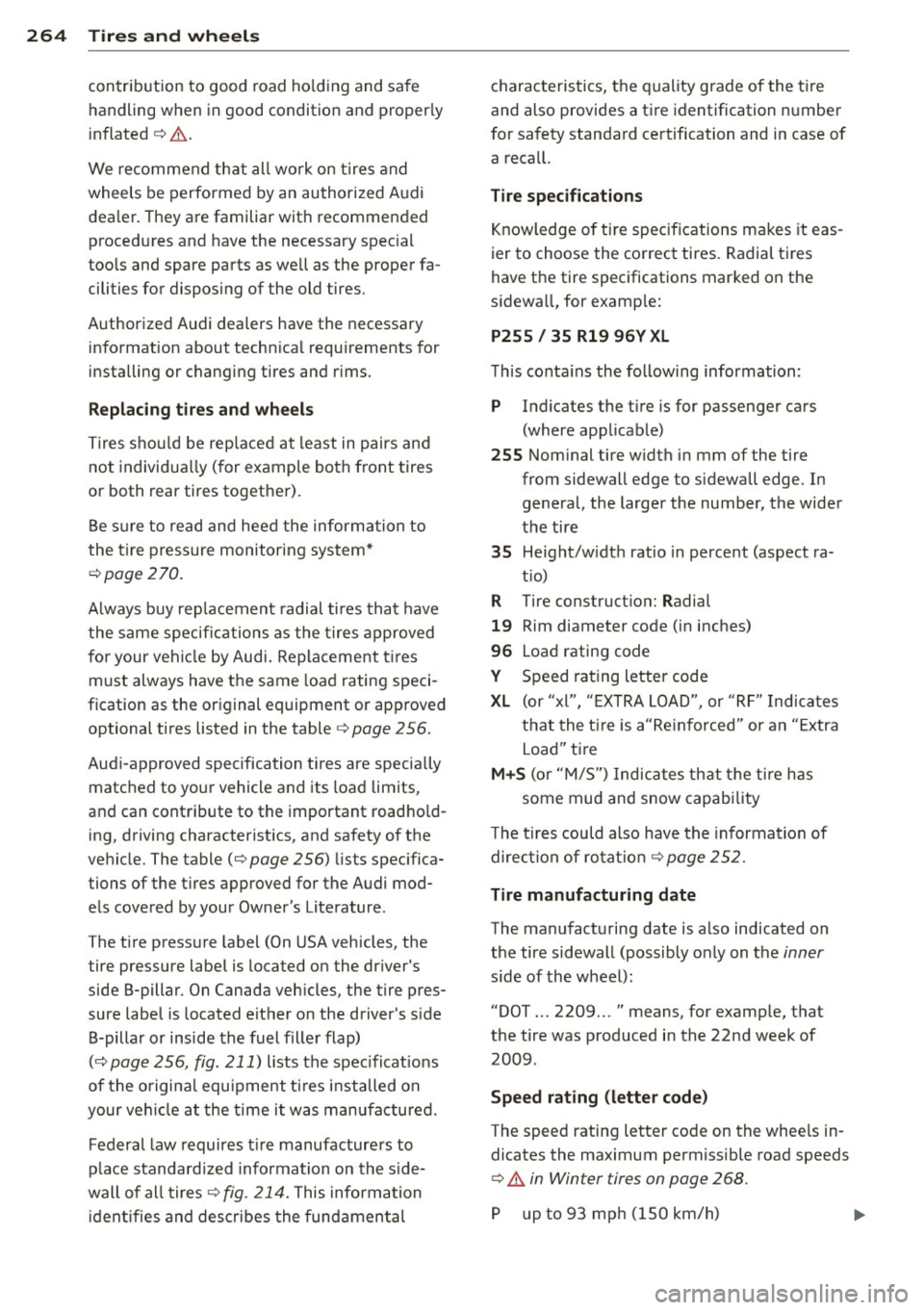
264 Tire s and wheel s
contribution to good road ho lding and safe
handling when in good condition and properly
inflated ¢
,&.
We recommend that all work on tires and
wheels be perfo rmed by an authorized Audi
dea ler. They are familiar with recommended
proced ures and have the necessary spec ial
too ls and spare parts as well as the proper fa
cilities for disposing of the old tires.
Authorized Audi dealers have the necessary information about techn ica l requ irements for
installing or changing tires and r ims.
R eplacing t ires and whe els
Tires sho uld be rep laced at least in pairs and
not individua lly (for examp le both front tires
or both rear tires together).
Be sure to read and heed the information to
the tire pressure monitoring system*
¢page 270.
Always buy rep lacement radial tires that have
the same specifications as the tires approved
for your vehicle by Audi. Replacement t ires
must always have the same load rating speci
fication as the original equipment or approved
optional tires listed in the table
c:> page 256.
Aud i-approved specification ti res are specially
matched to your vehicle and its load limits,
and can contribute to the important road ho ld
ing, driving characteristics, and safety of the
vehicle. The table
(<:>page 256) lists spec ifica
tions of the tires approved for the Audi mod
els covered by your Owner's Literature .
The tire pressure labe l (On USA vehicles, the
tire pressure label is located on the driver's
side B-pillar. On Canada veh icles, the tire pres
sure label is located either on the driver's s ide
B-pillar or inside the fuel filler flap)
(¢page 256, fig. 211) lists the spec ificat ions
of the origina l equipment ti res installed on
your ve hicle a t the time it was manufactured.
Federal law requires t ire manufacturers to
p lace standard ized information on the s ide
wall of all tires
c:> fig. 214. This information
ident ifies and describes the fund amental characteristics, the q
uality grade of the ti re
and also provides a tire identification n umber
for safety standard certification and in case of
a reca ll.
Tire specification s
Knowledge of ti re specif ications makes it eas
ier to choose the co rrect tires. Radial tires
have the tire specifications marked on the
sidewa ll, for examp le:
P255 / 35 R1 9 96Y XL
This conta ins the following information :
P Indicates the tire is for passenger cars
(where app licab le)
2 55 Nom inal tire w idth in mm of the tire
from sidewall edge to sidewall edge. In
general, the larger the number, the wider
the tire
35 Height/w idt h ratio in percent (aspect ra-
t io)
R Tire construct ion: Radial
19 Rim diameter code (in inches)
96 Load rating code
Y Speed rating letter code
XL (or "xl", "E XTRA LOAD", or "RF" Indica tes
that the t ire is a"Re in forced" or an "Extra
Load" ti re
M+S (or "M/5") Indicates that the tire h as
some mud and snow capability
T he tires could also have the information of
direction of rotat io n ¢
page 252.
Tire manuf acturing date
The manufacturing date is also indicated on
the tire sidewall (possibly only on the
inner
side of the wheel):
"DOT ... 2209 ... "means, for example, that
the tire was produced in the 22nd week of
2009.
Speed rating (letter c ode )
The speed rating letter code on the whee ls in
dicates the maximum permiss ible road speeds
c:> & in Winter tires on page 268 .
P up to 93 mph (150 km/h)
Page 267 of 316
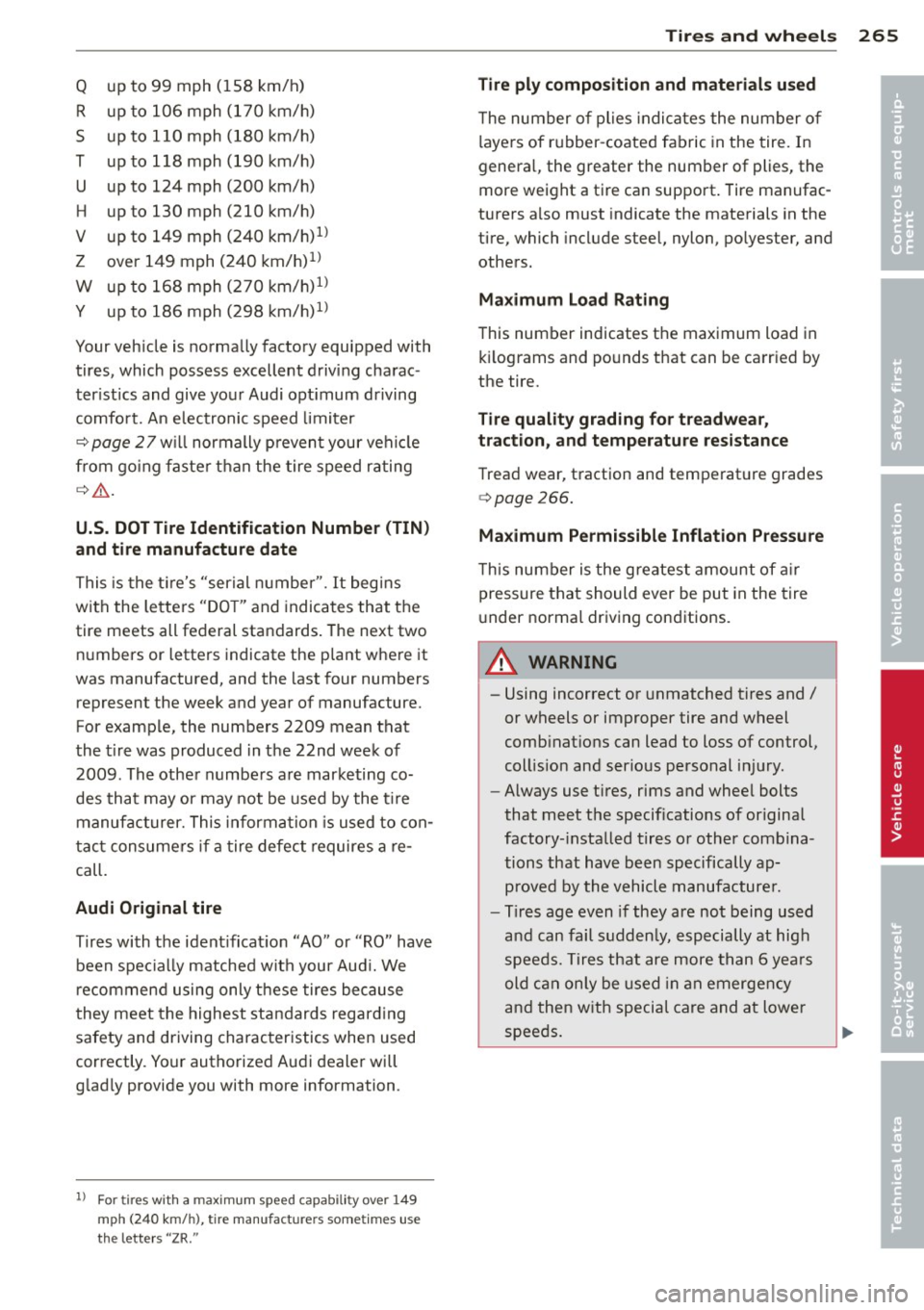
Q up to 99 mph (158 km/h)
R up to 106 mph (170 km/
h)
s up to 1 10 mph (180 km/ h)
T up to 118 mph (190 km/h)
u up to 124 mph (200 km/h)
H up to 130 mph (210 km/h)
V up to 149 mph (240 km/h)1
)
z over 149 mph (240 km/h)ll
w up to 168 mph (270 km/h)1l
y up to 186 mph (298 km/h)1l
Your veh icle is normally factory equipped with
tires, which posse ss excellent driving charac
ter ist ics and give your Audi opt imum dr iving
comfort. An electronic speed limiter
q page 27 w ill normally p revent your vehi cle
from go ing faster than the tire speed ra ting
Q .&. .
U.S. DOT Tire Identification Number (TIN)
and tire manufa ctur e date
This is the t ire's "serial number". It begins
with the lette rs "DO T" and indicates that the
tire meets all federal standards . The next two
numbers or letters indicate the p lant where it
w as manufactured, and the last four numbers
represen t the week and ye ar of manufacture .
For example, the numbers 2209 mean that
the t ire was produced in the 22nd week of
2009 . The othe r numbe rs are marketing co
des that may or may not be used by the t ire
manufacturer. This informa tion is used to con
t act consume rs if a tire defect requires a re
call.
Audi Original tir e
Tires with the ident ificat ion "AO" or "RO " have
been spec ially matched with your Aud i. We
recommend using only t hese tires because
they meet the highest standards regard ing
safety and driving characteristics when used
correctly. Your authorized Audi dealer will
g lad ly p rovide you with mo re info rmation .
ll Fo r tires wit h a m ax im um s pee d ca pabil ity over 149
mph (2 4 0 k m/h) , tire ma nufa cturers some times use
t h e le tters "Z R."
Tire s an d wheel s 265
Tire ply composition and material s used
The number o f plies indicates the number o f
l aye rs of r ubber-coated fabric in the tire. In
genera l, the greater the number of plies, the
more weight a tir e can support . Tire manufac
turers also must indicate the materials in the
tire, which include steel, nylon, po lyester, and
others.
Maximum Load Rating
T his number indicates the maximum load in
ki lograms and po unds that can b e carried by
the tire.
Tire quality grading for treadwear,
tract ion , and temperature resistance
Tread w ear, traction and t emperat ure grades
q page 266.
Ma ximum Permissible Inflat ion Pre ssure
T his number is the greatest amount of a ir
pressure that should ever be put in the tire
u nder normal dr iving conditions.
A WARNING
- Using incorrect or unmatched tires and I
or wheels or improper tire and wheel
comb inat ions can lead to loss of control,
col lis ion and serious personal injury.
- Always use t ires, rims and whee l bolts
that meet the specifications of original
factory- installed tires or other combina
tions that have been specifically ap proved by the vehicle manufacture r.
- Tires age even if they are not being used
and can fail sudden ly, especially at high
speeds. Tires that are more than 6 yea rs
old c an only be used in an emerge ncy
an d then w ith special care and at lower
spee ds.
•
•
Page 268 of 316
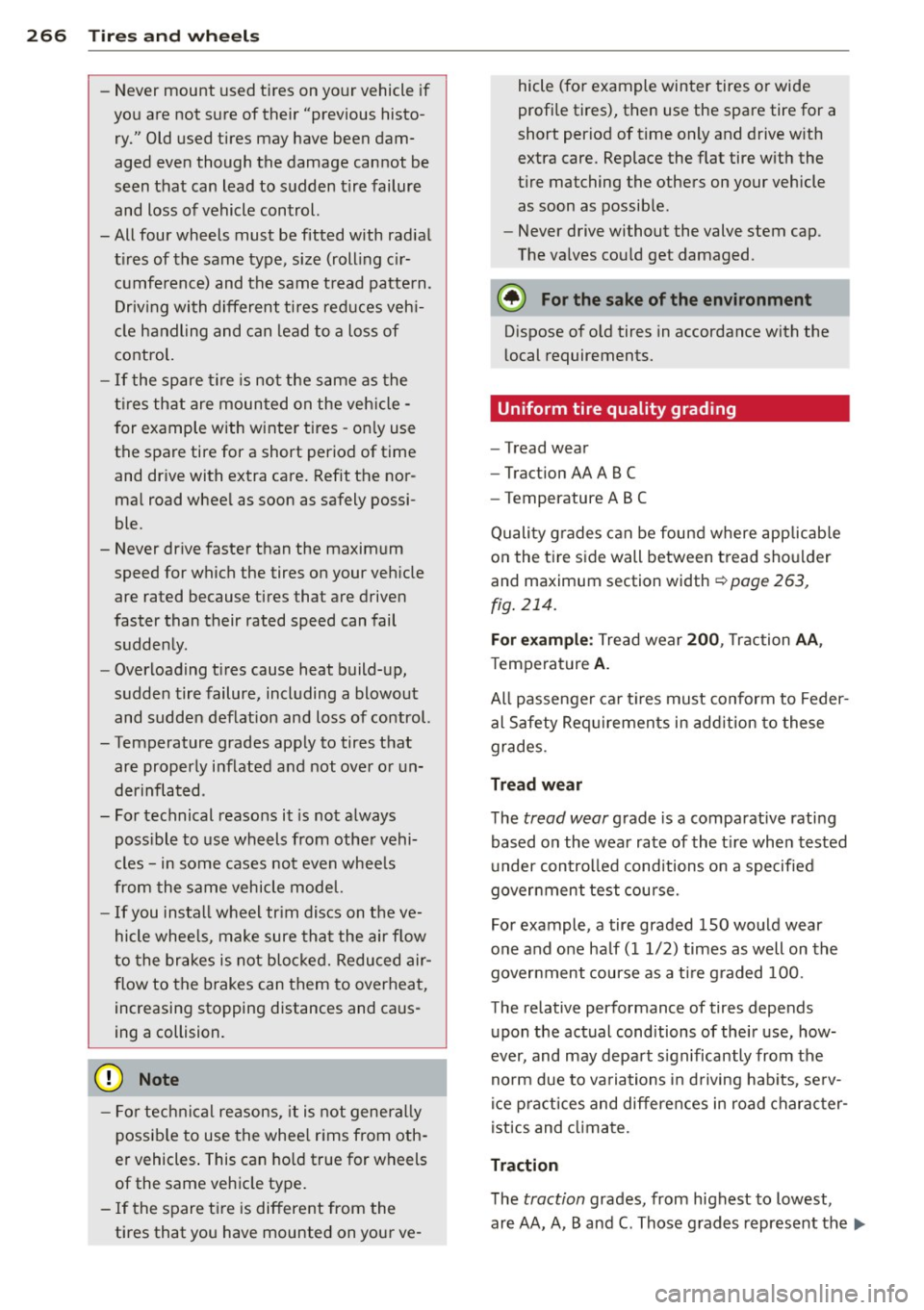
26 6 T ire s and whee ls
- Never mount used tires on yo ur vehicle if
you are not sure of their "previous histo
ry." Old used tires may have been dam
aged even though the damage cannot be
seen that can lead to sudden tire failure
and loss of vehicle control.
- All four wheels must be fitted with radial
tires of the same type, size (roll ing c ir
cumference) and the same tread pattern.
Driv ing with different ti res reduces veh i
cle handling and can lead to a loss of
control.
- If the spare t ire is not the same as the
t ires that are mounted on the veh icle -
f or example with winte r tires -on ly use
the spare tire for a short period of time
and dr ive with extra care. Refit the nor
ma l road whee l as soon as safely possi
ble.
- Never drive faster than the maximum speed for which the tires on your veh icle
are rated because tires that are driven
faster than their rated speed can fail
suddenly.
- Overloading t ires cause heat build-up,
sudden tire failure, including a blowout
and sudden deflation and loss of control.
- Temperature grades apply to tires that
are properly inflated and not over or un
derinflated .
- For technical reasons it is not always
poss ible to use wheels from other vehi
cles -in some cases not even whee ls
from the same vehicle model.
- If you install wheel tr im discs on the ve
hicle whee ls, make sure that the air flow
to the brakes is not blocked. Reduced air
flow to the brakes can them to overheat, increasing stopping distances and caus
ing a collision.
0 Note
- For technical reasons , it is not general ly
possib le to use the whee l rims from oth
er vehicles . This can ho ld true for wheels
of the same vehicle type.
- If the spare tire is different from the
tires that you have mounted on your ve- hicle (fo
r example winter tires or wide
profi le tires), then use the spare tire for a
short period of time only and drive w ith
extra care. Replace the flat tire with the
tire matching the others on your vehicle
as soon as possib le.
- Never drive without the valve stem cap.
The va lves could get damaged.
@ For the sake of the env ironment
D ispose of o ld tires in accordance with the
l ocal requirements.
Uniform tire quality grading
- Tread wear
- Traction AA A B C
- Temperature ABC
Quality g rades can be found where applicab le
on the tire side wall between tread sho ulder
and maximum section width
~ page 263,
fig . 214.
For exampl e: Tread wear 200, Trac tion AA ,
Tempe rature A.
All passenge r car t ires must conform to Feder
al Safety Requirements in add ition to these
grades .
Tread w ear
The tread wear grade is a comparative rating
based on the wear rate of the t ire when tested
under controlled conditions o n a specified
government test course.
For example, a tire graded 150 would wear
one and one ha lf (1 1/2) times as well on the
gover nment course as a ti re g raded 100 .
The relative performance of tires depends upon the actual conditions of their use, how
ever, and may depart s ignificantly from the
no rm due to va riations i n driving hab its, se rv
ice practices and differences in road charac ter
istics and cl imate.
Traction
The traction grades, from highest to lowest,
are AA, A, Band
C. Those grades represent the ..,.
Page 269 of 316
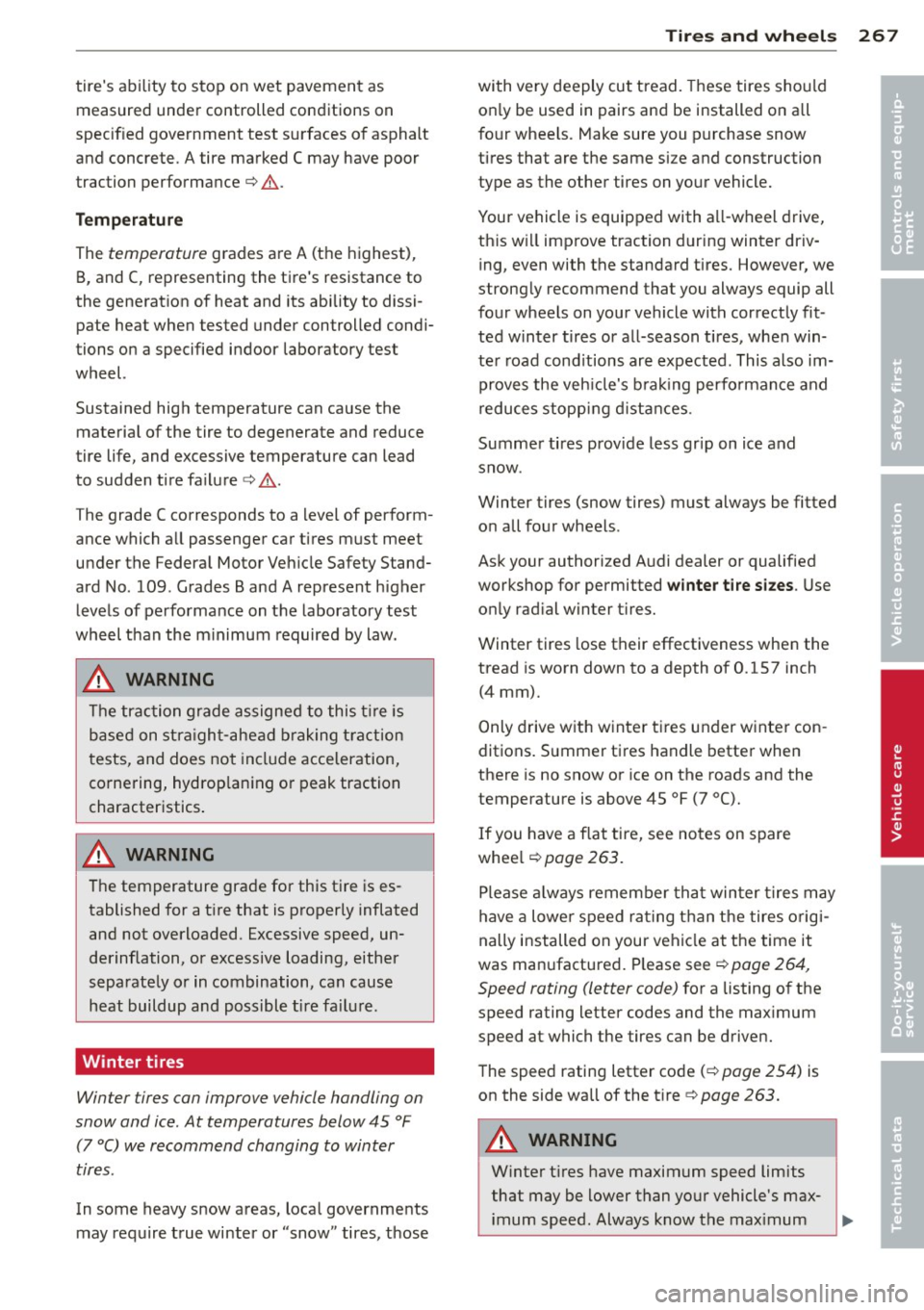
tire's ability to stop on wet pavement as measured under controlled conditions on
specif ied government test surfaces of asphalt
and concrete. A tire marked C may have poor
t raction performance¢ .&,.
Temp eratu re
The temperature grades are A (the highest),
B, and
C, representing the tire's resistance to
the generation of heat and its ability to dissi pate heat when tested under controlled condi
tions on a specified indoor laboratory test
wheel.
Sustained high temperature can cause the material of the tire to degenerate and reduce
tire life, and excessive temperature can lead
to sudden tire failure ¢.&, .
T he grade
C corresponds to a level of perform
ance which all passenger car tires must meet
under the Federa l Motor Veh icle Safety Stand
ard No.
109 . Grades Band A represent higher
levels of performance on the laboratory test
wheel than the m inimum required by law.
.8, WARNING
The trac tion grade assigned to this t ire is
b ase d on stra ight-ahead brak ing t raction
t ests, and does not inclu de acceleration,
co rnering, hydrop laning or peak traction
characteristics .
.8, WARNING
The temperature grade for this tire is es
tablished for a t ire that is properly inflated
and not overloaded . Excessive speed, un
derinflation, or excessive loading, either
separate ly or in combination, can cause
heat buildup and possible ti re fa ilu re.
Winter tires
Winter tires can improve vehicle handling on
snow and ice . At temperatures below 45 °F
(7 °C) we recommend changing to winter
tires.
-
In some heavy snow a reas, loca l governme nts
may require t rue winter or "snow" tires, those
Tires an d wheel s 267
with very deeply cut tread. These tires should
o nl y be used in pairs and be installed o n all
fo ur wheels. Make sure you purchase snow
tires that are the same si ze and construction
type as the other tires on your vehicle.
Your vehicle is equipped with a ll-wheel drive,
th is w ill imp rove traction d uring winter driv
ing, even with the standard tires. However, we
strong ly rec ommend that you always equip all
fou r wheels on you r vehicle with correctly fit
ted w inter t ires or al l-season t ires, when win
te r road cond itions ar e expected . This also im
proves the veh icle's b ra ki ng perfo rman ce and
reduces stopping d ista nces .
Summe r tires p rovide less grip on ice and
snow .
Winter tires (snow tires) must always be fitted
o n all four wheels .
Ask your authorized A udi dealer or qualified
workshop for permitted
winter tire sizes . Use
only rad ial winter t ires.
Winter tires lose their effectiveness whe n the
tread is worn down to a depth of
0.157 inch
(4 mm).
Only drive with winter tires under winte r con
ditions. S ummer t ires handle better when
there is no snow or ice on the roads and the
temperature is above 45 °F (7 °().
If you have a flat t ire, see no tes on spare
whee l ¢ page 263.
P lease alway s remember tha t win ter tire s m ay
have a lowe r speed ra ti ng than the tires orig i
nally installed on your vehi cle at the time it
was man ufactured. Please see ¢page 264,
Speed rating (letter code) for a listing of the
speed rating letter codes and the max imum
speed at which the tires can be driven.
T he spee d rating letter code (¢ page 254) is
on the side wall of the t ire ¢page 263.
.8, WARNING
Winter t ires have maximum speed limits
that may be lower than yo ur vehicle's max-
imum speed . Always know the max imum
~
•
•
Page 270 of 316
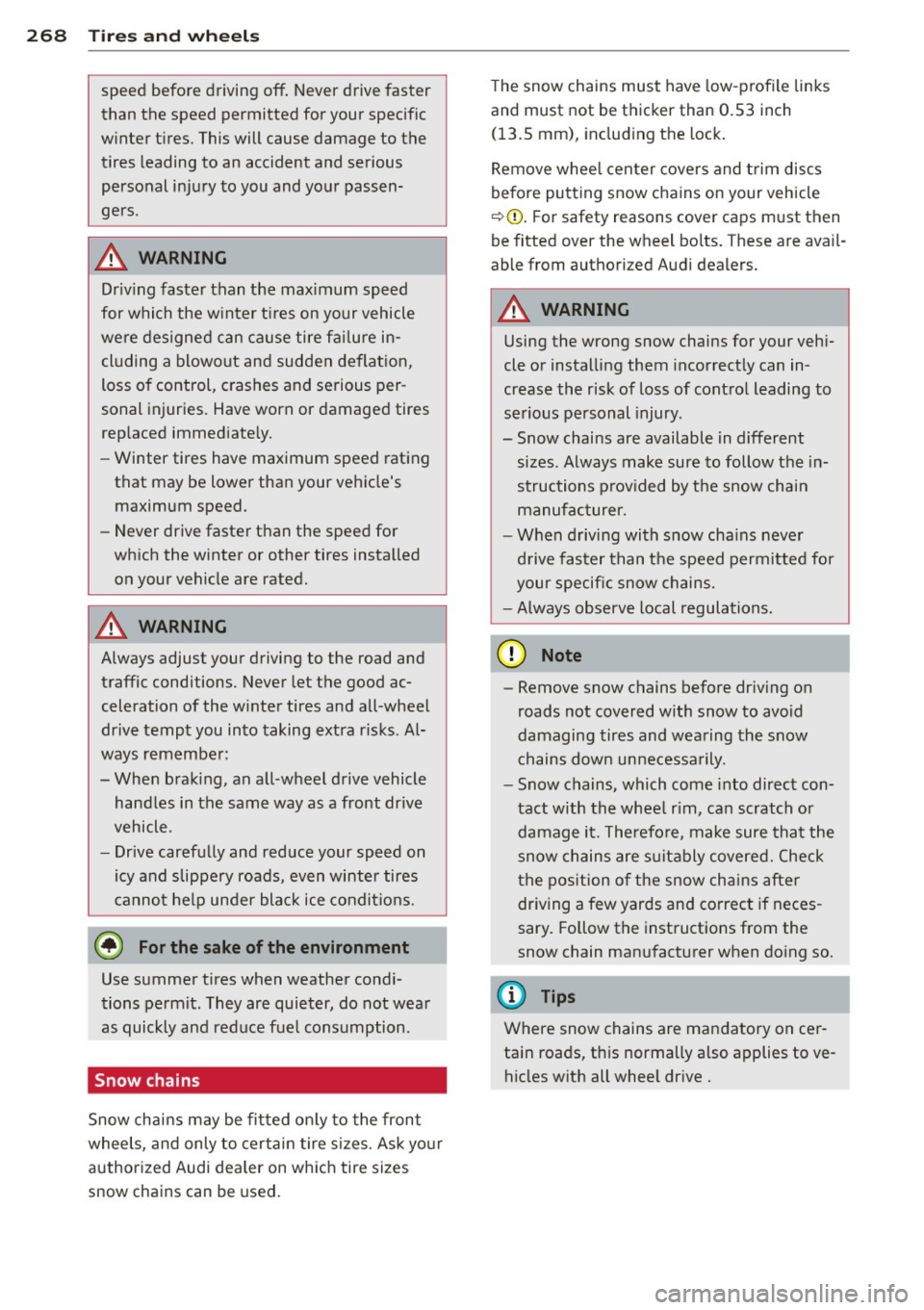
268 Tire s and wheel s
speed before driving off . Never drive faster
than the speed permitted for your specific
winter t ires. This will cause damage to the
tires leading to an accident and serious
personal injury to you and your passen
gers .
A WARNING
Driv ing faster than the maximum speed
for which the w inter t ires on your vehicle
were designed can cause tire fa ilu re in
cluding a blowout and sudden deflat ion,
loss of control, crashes and serious per
sonal injuries. Have worn or damaged tires
rep laced immed iate ly.
- Winter tires have maximum speed rating
that may be lower than your vehicle's
maximum speed .
- Never drive faster t han the speed for
which the winter or other tires installed
on your vehicle are rated.
A WARNING
Always adjust your driving to the road and
traffic conditions. Never let the good ac
celeration of the winte r tires and all -wheel
drive tempt you into taking extra r is ks. Al
ways remembe r:
- When brak ing, an all -wheel drive vehicle
handles in the same way as a front drive
vehicle .
- Drive carefu lly and reduce your speed on
icy and slippery roads, even winter tires
canno t he lp under black ice condit io ns.
@ For the sake of the environment
Use summer tires when weather cond i
tions permit . They are quieter, do not wea r
as quickly and reduce fue l consumption .
Snow chains
Snow chains may be fitted on ly to the front
wheels, a nd only to certa in tire sizes. Ask yo ur
author ized Audi dealer on wh ich tire sizes
snow chains can be used. The snow chains must have
low -profile links
and must not be thicker than 0 .53 inch
(13.S mm), includ ing the lock.
Remove whee l cen ter cove rs and t rim discs
before putting snow chains on your vehicle
¢ 0 . For safety reasons cover caps m ust then
be fitted over the wheel bolts. These are avail
a ble from authori zed Aud i dealers.
A WARNING
Using the wrong snow chains for your veh i
cle o r instal ling them incorrectly can in
crease the risk of loss of cont rol leading to
serious pe rsonal injury .
- Snow chains are available in different
sizes . Always make sure to follow the in
structions p rov ided by t he snow cha in
manufac turer.
- When driving with snow cha ins never
d rive faster than the speed permitted for
your specifi c snow chains.
- Always observe local regulations.
@ Note
-Remove snow chains before dr iv ing o n
roads not covered with snow to avoid
damaging tires and wea ring the snow
chains down un necessa rily .
- Snow chains, which come into direc t con
tact with the whee l rim, can scratch or
damage i t. Therefo re , make sure tha t the
snow chains are s uitably covered. Check
t he pos ition of t he snow chains after
driving a few yards and correct if neces
sary. Follow the inst ructions from the
snow chain man ufacturer when do ing so.
(I) Tips
Where snow chains are mandatory on cer
tain roads, th is normally a lso applies to ve
hicles w ith all whee l dr ive .